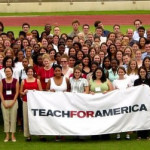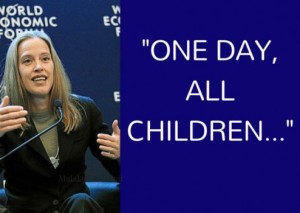www.TFA.org
| Offering |
For Graduating College Seniors: For Low-Income U.S. School Districts: |
| Value Proposed |
For Graduating College Seniors: For Low-Income U.S. School Districts: |
| Key Resources Leveraged | Strengths of select graduating college seniors — Channeled to a purpose more motivating to them than status quo purposes. |
| Societal Progress | “People” throughout society. Intended direct effect is change in cultural consciousness that will lead to more equal schooling opportunity. Intended eventual effect is broader access among K-12 students to thriving adult lives. |
1. Agent’s Path to Offering
Observing Incongruity —
- Wendy Kopp observed as a college freshman that her roommate was “brilliant.” So it was striking to Kopp when she saw that her roommate “struggled under the academic demands of Princeton” when Kopp’s perception of norm was not to struggle, even with lower aptitude.
- The difference Kopp perceived was that her roommate went to K-12 schools in low-income neighborhoods.
- Kopp saw this as an indicator of how much there is unequal educational opportunity in the U.S.
- She saw it as social injustice, rooted in culture: The accepted status quo was inconsistent with what Americans professed to value.
The observation made a strong and lasting impression:
- “As I moved through Princeton I grew increasingly aware of students’ unequal access to the kind of educational excellence I had previously taken for granted.”
- “I wanted to figure out what could be done about this problem, and so I organized a conference about the issue.”
2. Hypothesis of “What Could Be” As New Value:
Kopp connected knowledge she gained from the conference with existing pertinent knowledge (in particular, deep knowledge of her “customer” peers), with the result of the initial hypothesis for Teach for America:
In Kopp’s words:
- “The idea was to create a corps of top recent college graduates – people of all academic majors – who would commit two years to teach in public schools in low-income urban and rural areas. Called Teach for America, this corps would mobilize some of the most passionate, dedicated members of my generation to change the fact that where a child is born in the United States largely determines his or her chances in life.”
- “We would jump at a chance to be part of something that brought thousands of our peers together to address the inequities in our country and to assume immediate and full responsibility for the education of a class of students.”
- “(A) national teacher corps could produce change in the very consciousness of our country.
Sample Knowledge Connected in “What Could Be” Hypothesis:
Industry Knowledge (K-12 Education)
- At the conference, one of the speakers “maintained that people without education degrees were frequently hired by public schools because there weren’t enough education majors interested in teaching in low-income communities.”
- Kopp also was aware of the example of effective teaching without an education degree in private K-12 schools.
Customer Knowledge — “Top college graduates”
- “Just about every Princeton senior” was applying to a two-year corporate training program, most with investment banks and management consulting firms.
- Yet most of the people Kopp knew were heading to these programs because they were recruited aggressively and because “they couldn’t think of anything else to do,” not because they were “dead-set on making money or because of a deep interest in business or high finance.
- “I sensed that I was not alone — that there were thousands of other seniors like me who were searching for jobs that would offer them significance and meaning.”
- At the conference: “Nearly all of the student participants … said that they would teach in public schools if it were possible for them to do so.”
Human-Social Knowledge
- Sense of the force of action over words — for shining light on a cultural issue.
- Sense of the lifelong effect that the TFA experience would have on the corps members:
“Some would stay in education … Others would remain advocates for social change and education reform. They would become school board members. They would become mayors and state legislators, U.S. senators, and Supreme Court justices. And they would make better decisions because of their experiences teaching in public schools.”
3. “How” Hypotheses
 Upon imagining the possibility of Teach for America, Kopp made the idea the topic for her senior thesis, with focus on “how” hypotheses:
Upon imagining the possibility of Teach for America, Kopp made the idea the topic for her senior thesis, with focus on “how” hypotheses:
“I withdrew from the world – skipping whatever classes I could and talking to just about no one — in order to research the viability of a national teacher corps.”
Her thesis work included looking into “the teacher corps that had been run by the federal government in the 1960s” — in order to understand what had been tried before.
It also included an operations model and strategic plan, including estimated costs ($2.5 million for the first year). Overall:
- Establish a non-profit organization that would enter into contracts with low-income school districts for hiring corps members as teachers for a two-year commitment.
- Recruit college seniors with timing, assertiveness, and savvy similar to the corporate recruiters.
- Establish an effective summer training program for corps members.
Kopp’s work paid off when a business executive found her vision compelling and became an informal advisor, including advising her on how to obtain funding.
Enterprise Model:
| Key Customers & Relationships | |
| Select College Seniors — Inspire & Support
School Districts — Earn Trust in TFA Offerings K-12 Students & Families — Relate & Support Achievement |
|
| Key Activities: |
Channels of Distribution: |
| Program Management: Recruit corps members & school districts. Design training and overall support systems. Manage relationships. Raise funds. Etc. |
Recruit corps members at universities in sync with recruitment competition. Contract with school districts to hire corps members. |
| Key Partners: |
Key Resources: |
| Universities as hosts for “summer institute” for training corps members. | Corps Member Strengths & Commitment. Energy of intrinsic motivation. |
| Key Costs: | Revenue Streams: |
| Limited Paid Staff. Programming Costs. Sample Costs Avoided: Subsidized facilities for summer training. |
Teachers paid by districts.
Donations to support the organization. |
Sample Knowledge Connected in “How” Hypotheses:
Customer Knowledge (Deep):
- Understanding, for example, the status quo cycle of recruitment on the college campuses and recognizing that TFA would need to time their recruitment and craft their message to be competitive.
- Understanding that graduates would need to know that they were accepted/hired well before their college graduation, again in sync with competing opportunities.
- Understanding that not just any student — no matter how academically successful — would be a good TFA candidate. TFA determined criteria for selection and crafted intensive interviewing processes.
Industry Knowledge:
- Model of U.S. Peace Corps & understanding of its development and implementation.
- Model of U.S. private school teaching by uncertified teachers, often with qualities similar to Kopp’s peers.
- What has been tried before to address purpose of educational opportunity.
Anything & Everything
- Kopp had deep personal experience with planning and implementing initiatives.
- She also knew herself — her personal strengths & values.
4. Change by Way of Value?
Did enthusiastic adoption by the customer segments of new college graduates and high-poverty schools catalyze the intended direct advance in cultural consciousness about educational opportunity and the ultimate advance in better futures for more low-income students?
i. 20+ Years of Recruitment Success
Teach for America’s extraordinary success in attracting college student applicants has been fundamental to its action-based message of commitment:
- For over 20 years, new corps each year of some 10,000 members
- Resulting from selecting only one in ten applicants — from an overall pool of high-achieving applicants.
- For multiple years, at campuses where TFA recruited, more students applied to TFA than to any other recruitment.
- There has been clear value in the offering to the college student customers.
ii. Effectiveness in the K-12 Schools
Multiple evaluation studies have shown that TFA teachers, on average, have been at least as effective in classrooms as the schools’ regular certified teaching staffs. Many school districts have continued to hire corps members, though in some cities resistance (e.g., from teacher unions) has eliminated the partnership.
Effective teaching has been associated with corps members’ commitment. Reports indicate consistently that the work is very hard and the hours long if not extraordinary (and many observers would say unsustainable). The vast majority of corps members have completed their two-year commitment.
As Kopp imagined, a segment of TFA alumni have continued to work directly to influence educational opportunities for low-income students, as teachers, administrators, researchers and teacher educators, and more. For example:
- In 1995, two new TFA alumni founded two charter schools named KIPP (Knowledge is Power), with success leading to a national network of KIPP schools as of 2000. In 2016, for the 183 KIPP schools in 20 states, 33% are TFA alumni.
- As one of the corps members who pursued doctoral study in Education, an alumnus worked directly with a national thought leader in the 2010 founding of an institute at the University of Michigan for improving teacher education.
- In 2016, three TFA alumni (from 1995, 2003, and 2004) continued to expand their personal influence on education opportunity by assuming leadership roles in the Texas Education Agency. See TFA’s release.
iii. Cultural Consciousness & Societal Changes?
Was there enough value in TFA’s offering of a truth force to catalyze societal change? To advance educational opportunity?
- Although there aren’t standard measures of cultural consciousness, TFA’s sustained visibility — even its sometimes controversial fit within public education — has played a likely role within a likely heightening of cultural consciousness.
- Continued engagement among a corps alumni
Limited change in the ultimate outcome of educational opportunity, from TFA and many separate efforts, speaks to the difficulty of this type of societal progress. At the same time, TFA has continued to inspire the force of purpose toward this end, among active corps members and alumni.
5. Why Do This Work?
Value:
Meaningful engagement of strengths.
“How can I match my intrinsic talent with one of the world’s deep needs?”
Wendy Kopp’s Innovation “Persona”:
Learner-Organizer Combination


